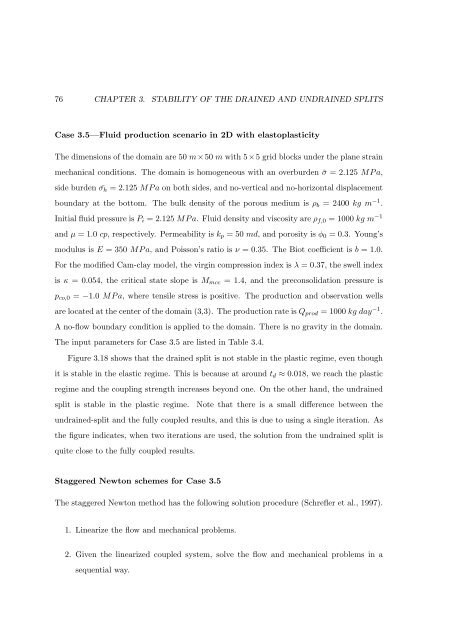Sequential Methods for Coupled Geomechanics and Multiphase Flow
Sequential Methods for Coupled Geomechanics and Multiphase Flow
Sequential Methods for Coupled Geomechanics and Multiphase Flow
You also want an ePaper? Increase the reach of your titles
YUMPU automatically turns print PDFs into web optimized ePapers that Google loves.
76 CHAPTER 3. STABILITY OF THE DRAINED AND UNDRAINED SPLITS<br />
Case 3.5—Fluid production scenario in 2D with elastoplasticity<br />
The dimensions of the domain are 50 m×50 m with 5×5 grid blocks under the plane strain<br />
mechanical conditions. The domain is homogeneous with an overburden ¯σ = 2.125 MPa,<br />
side burden ¯σh = 2.125 MPa on both sides, <strong>and</strong> no-vertical <strong>and</strong> no-horizontal displacement<br />
boundary at the bottom. The bulk density of the porous medium is ρb = 2400 kg m −1 .<br />
Initial fluid pressure is Pi = 2.125 MPa. Fluid density <strong>and</strong> viscosity are ρf,0 = 1000 kg m −1<br />
<strong>and</strong> µ = 1.0 cp, respectively. Permeability is kp = 50 md, <strong>and</strong> porosity is φ0 = 0.3. Young’s<br />
modulus is E = 350 MPa, <strong>and</strong> Poisson’s ratio is ν = 0.35. The Biot coefficient is b = 1.0.<br />
For the modified Cam-clay model, the virgin compression index is λ = 0.37, the swell index<br />
is κ = 0.054, the critical state slope is Mmcc = 1.4, <strong>and</strong> the preconsolidation pressure is<br />
pco,0 = −1.0 MPa, where tensile stress is positive. The production <strong>and</strong> observation wells<br />
are located at the center of the domain (3,3). The production rate is Qprod = 1000 kg day −1 .<br />
A no-flow boundary condition is applied to the domain. There is no gravity in the domain.<br />
The input parameters <strong>for</strong> Case 3.5 are listed in Table 3.4.<br />
Figure 3.18 shows that the drained split is not stable in the plastic regime, even though<br />
it is stable in the elastic regime. This is because at around td ≈ 0.018, we reach the plastic<br />
regime <strong>and</strong> the coupling strength increases beyond one. On the other h<strong>and</strong>, the undrained<br />
split is stable in the plastic regime. Note that there is a small difference between the<br />
undrained-split <strong>and</strong> the fully coupled results, <strong>and</strong> this is due to using a single iteration. As<br />
the figure indicates, when two iterations are used, the solution from the undrained split is<br />
quite close to the fully coupled results.<br />
Staggered Newton schemes <strong>for</strong> Case 3.5<br />
The staggered Newton method has the following solution procedure (Schrefler et al., 1997).<br />
1. Linearize the flow <strong>and</strong> mechanical problems.<br />
2. Given the linearized coupled system, solve the flow <strong>and</strong> mechanical problems in a<br />
sequential way.
















